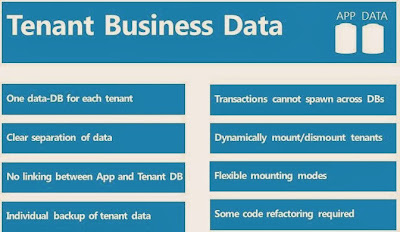Hi all,
With Release of NAV 2013 R2 a New Concept have been coined by Microsoft i.e Multi-tenant.
In this post we will try to understand the concept of Multi tenant and in next post we will see how we can actually implement it with the help of a demo database.
Below lines are from MSDN (view of Microsoft on Multi tenant) -
What is Single - Tenant Model?
In Single Tenant Model used till now, Application and Data Reside in Single Database.
To understand it simply i would say that data and Objects resides in a single database (physical & Logical)
What is Multi - Tenant Model?
In a Muti - Tenant Model introduced in NAV 2013 R2 we have an option to Move to Multi Tenant where we break the old database into Two Parts.
Part 1 Application (Objects only &Data Comman to All Companies Some System Tables)
Part 2 Data (Contain Data Specific to Companies & some System Tables)
Part 2 Can again be break into parts called as Tenant. You can have 1..n Tenant based on your requirement.
System tables in the tenant and application databases -
What benefit I Personally assume using this -
1) Only application Databases is accessible via developer environment. (Security to my database).
2) Databases are now separated based on company requirement. (Increased Performance - Faster Read & Write)
3) Based on Tenant Data, Databases can be stored in separate Disk.
4) Application Objects are shared with all tenant databases.
5) Tenants are separate identity and are not linked to Application Database.
In next set of Posts we will see how we can achieve partial & complete multi Tenant using a Sample Database.
Regards,
Saurav Dhyani
With Release of NAV 2013 R2 a New Concept have been coined by Microsoft i.e Multi-tenant.
In this post we will try to understand the concept of Multi tenant and in next post we will see how we can actually implement it with the help of a demo database.
Below lines are from MSDN (view of Microsoft on Multi tenant) -
"Microsoft Dynamics NAV 2013 R2 supports deployments where several different companies access a centrally maintained Microsoft Dynamics NAV application. By using this multitenancy support, you can add new customers to your solution easily, and you can roll out updates quickly with limited downtime for your customers."
"In a multitenant deployment, information about the Microsoft Dynamics NAV application is stored in a separate application database. Your customers’ data is stored in separate business databases, each of which is a tenant in your deployment. By separating application from data, you can deploy the same solution to many customers with centralized maintenance of the application and isolation of each tenant. The application database contains the tables that define an application, such as the Object table and other system tables."
What is Single - Tenant Model?
In Single Tenant Model used till now, Application and Data Reside in Single Database.
To understand it simply i would say that data and Objects resides in a single database (physical & Logical)
What is Multi - Tenant Model?
In a Muti - Tenant Model introduced in NAV 2013 R2 we have an option to Move to Multi Tenant where we break the old database into Two Parts.
Part 1 Application (Objects only &
Part 2 Data (Contain Data Specific to Companies & some System Tables)
Part 2 Can again be break into parts called as Tenant. You can have 1..n Tenant based on your requirement.
System tables in the tenant and application databases -
What benefit I Personally assume using this -
1) Only application Databases is accessible via developer environment. (Security to my database).
2) Databases are now separated based on company requirement. (Increased Performance - Faster Read & Write)
3) Based on Tenant Data, Databases can be stored in separate Disk.
4) Application Objects are shared with all tenant databases.
5) Tenants are separate identity and are not linked to Application Database.
In next set of Posts we will see how we can achieve partial & complete multi Tenant using a Sample Database.
Regards,
Saurav Dhyani





Comments
Post a Comment